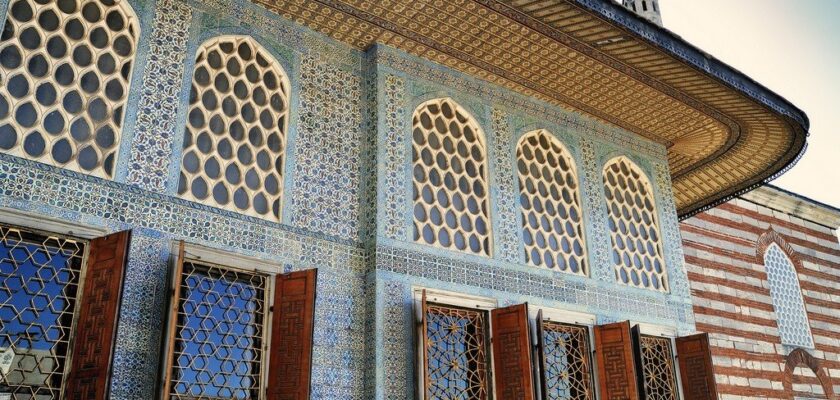Topkapı Palace
Topkapı Palace is the ancient residence of the Turkish sultans in Istanbul, which is an entire palace town. It is spread out on the high promontory of Sarayburnu, jutting into the Bosphorus. The total area of the palace building is 70 hectares, and every square meter here is drowned in luxury. Inclined to lush metaphors Muslim poets called Topkapi the Palace of eternal happiness, sent to its inhabitants by the Almighty himself, because the Turkish sultans also bore the title of caliphs – guardians of Islam.
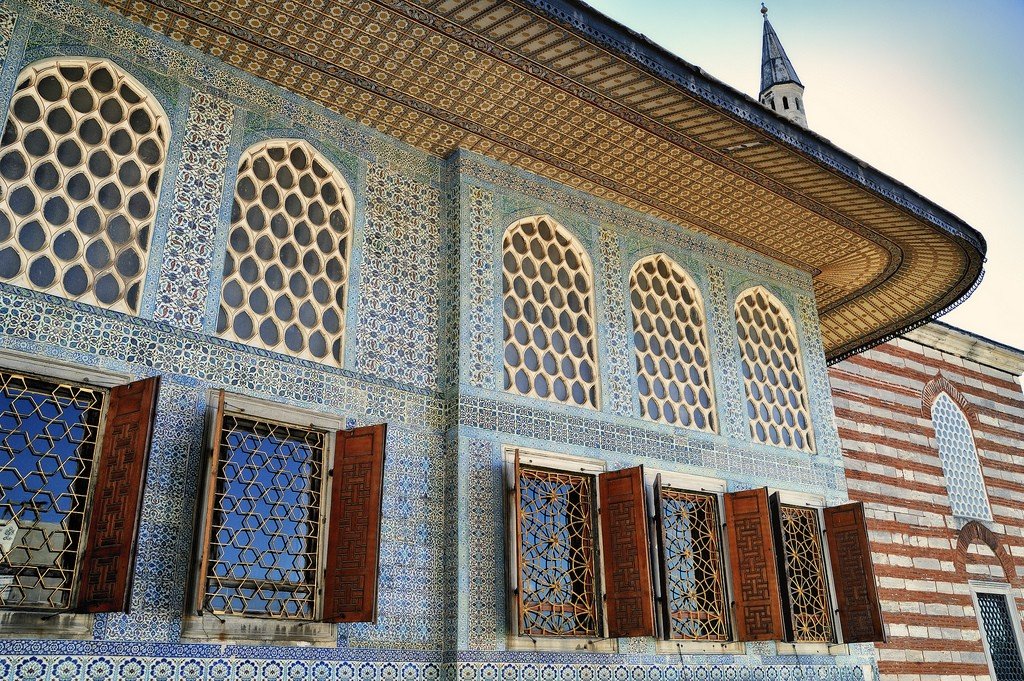
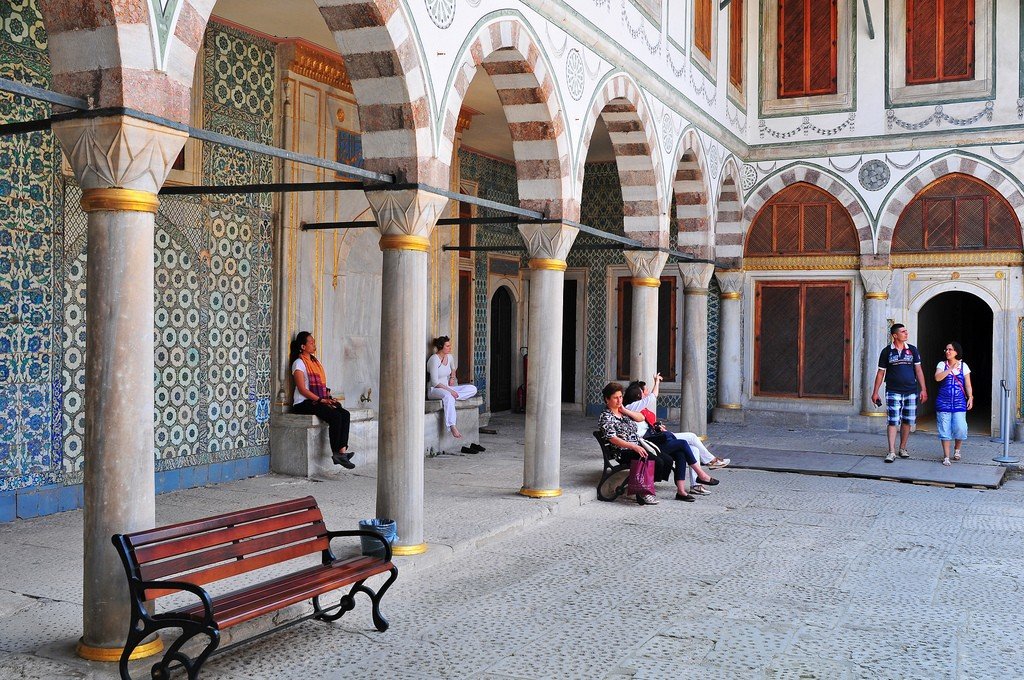
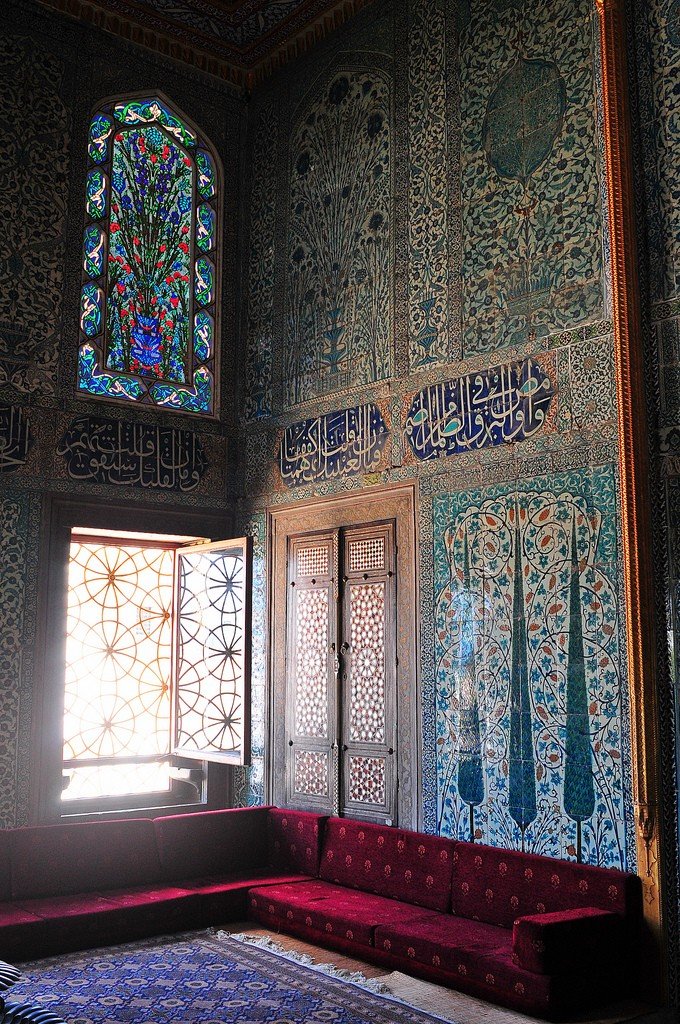
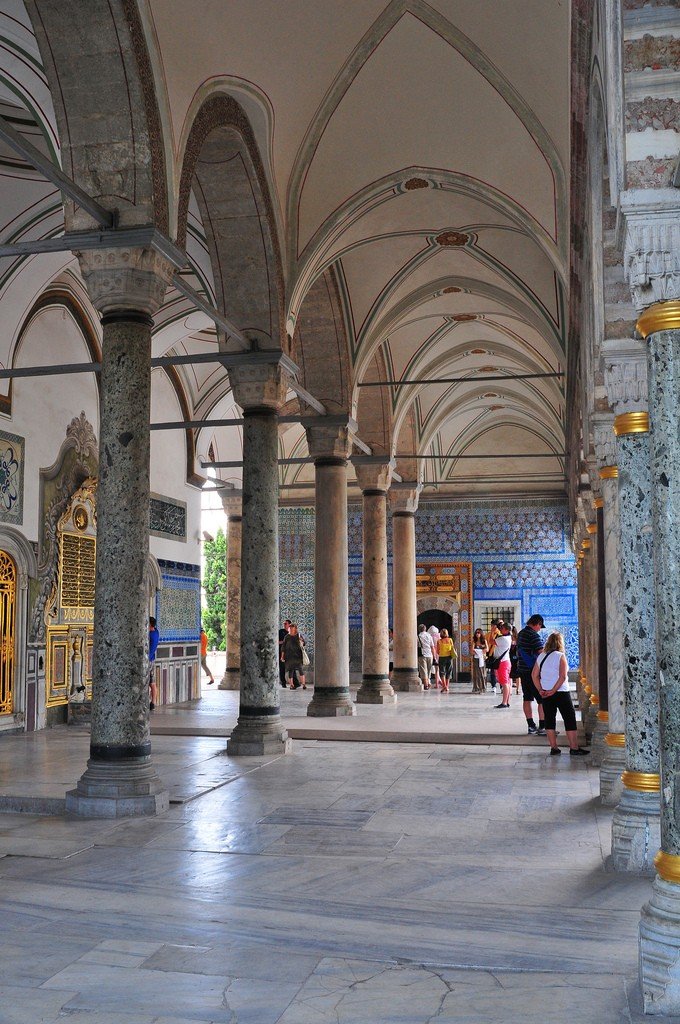
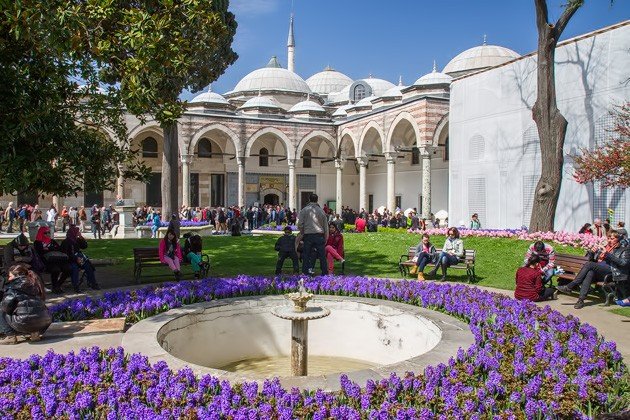
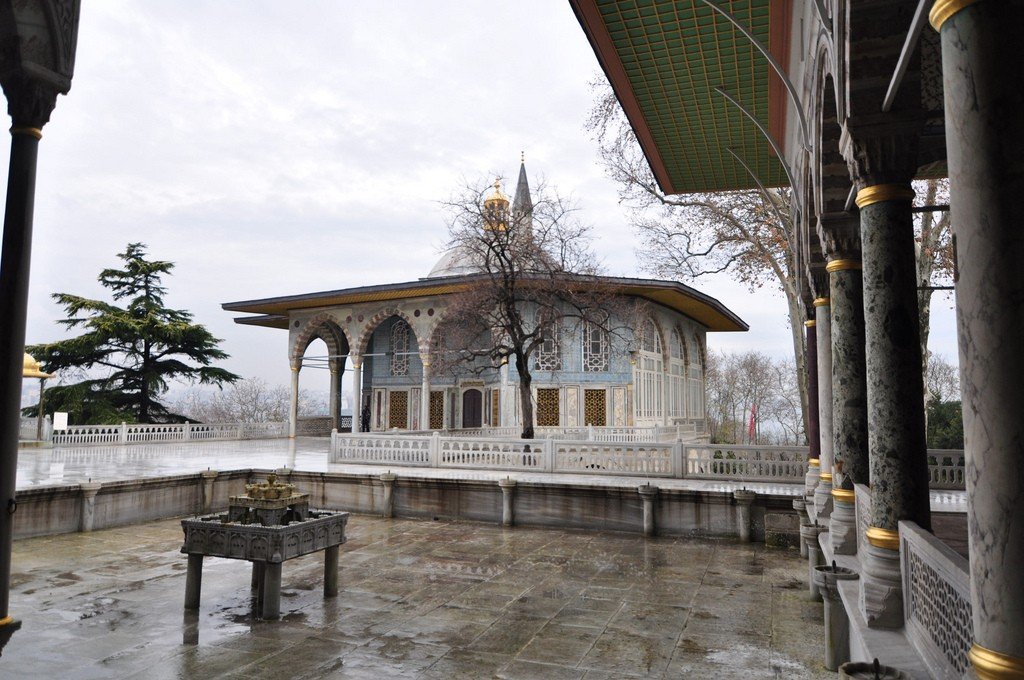
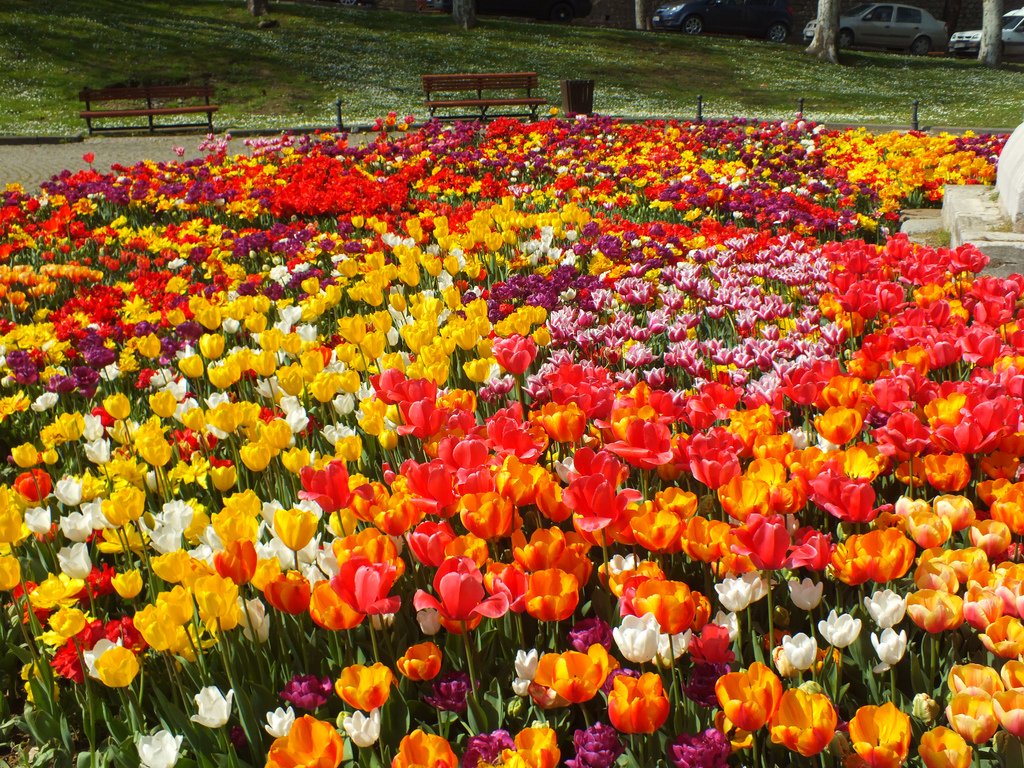
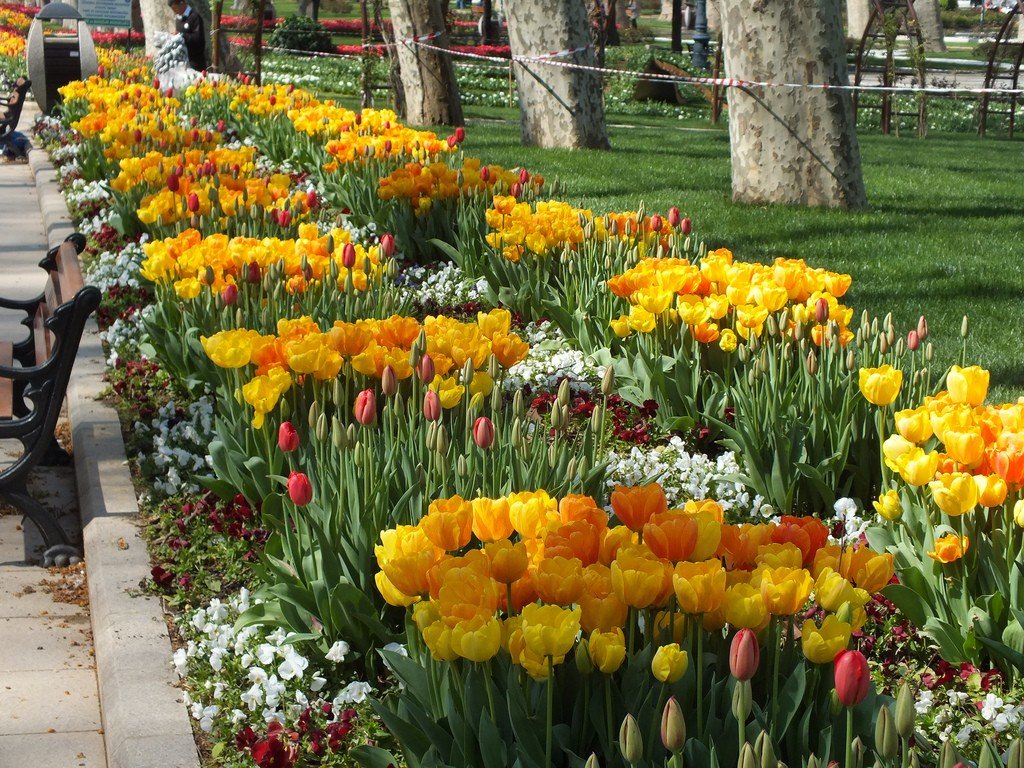
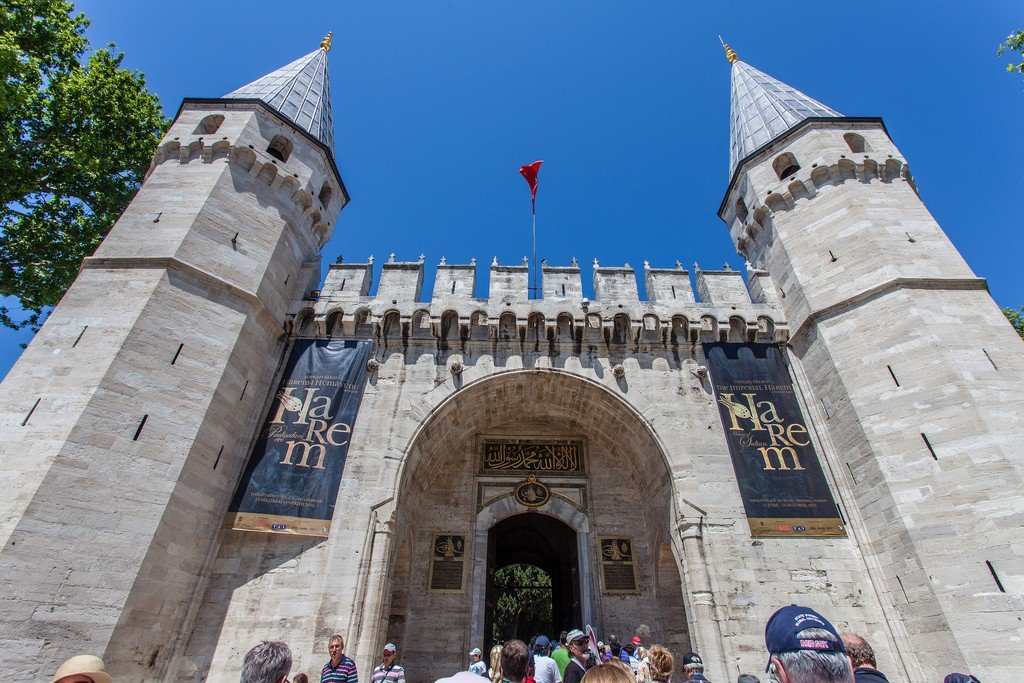
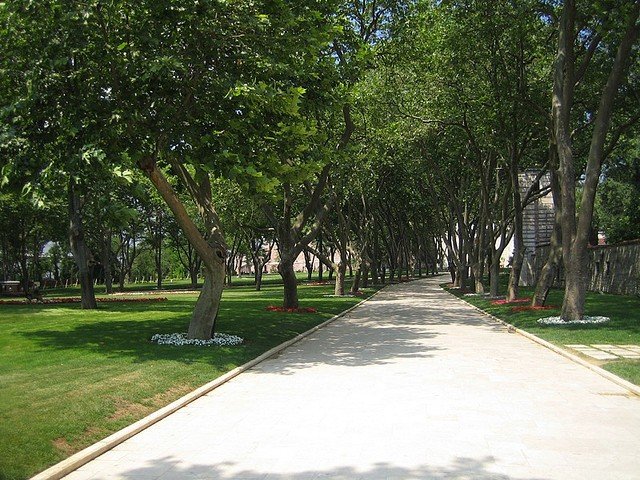
Video: Topkapi Palace
Contents- Highlights
- History of Topkapi Palace
- Museum objects and exhibitions
- Practical information
- How to get there
Highlights
In addition to the chambers of the rulers of the Ottoman Empire, Topkapi housed state offices and libraries, a treasury with untold riches, a harem, a huge kitchen, a military school, a mosque, an arsenal, and other buildings. Once there lived up to 4000 dignitaries of the highest rank, the palace was served and guarded by 50 000 soldiers. Now it is one of the most significant complexes of architectural monuments and museums of the Muslim world, storing the treasures of the rulers of the vast Ottoman Empire, which managed to conquer territories on three continents.
.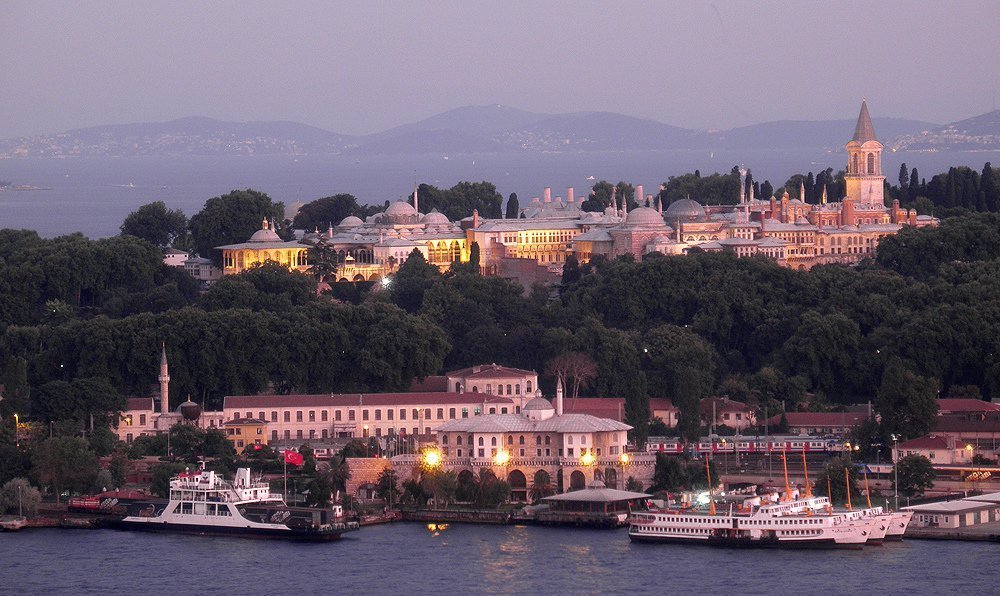
The popularity of this museum reached its peak after the release of the Turkish TV series “The Magnificent Century” (2011). Many episodes of the dramatic saga about the beautiful Roxolana, who managed to transform from a slave into the sultan’s favorite wife, were filmed in the interiors of the harem and other Topkapi palaces.
.’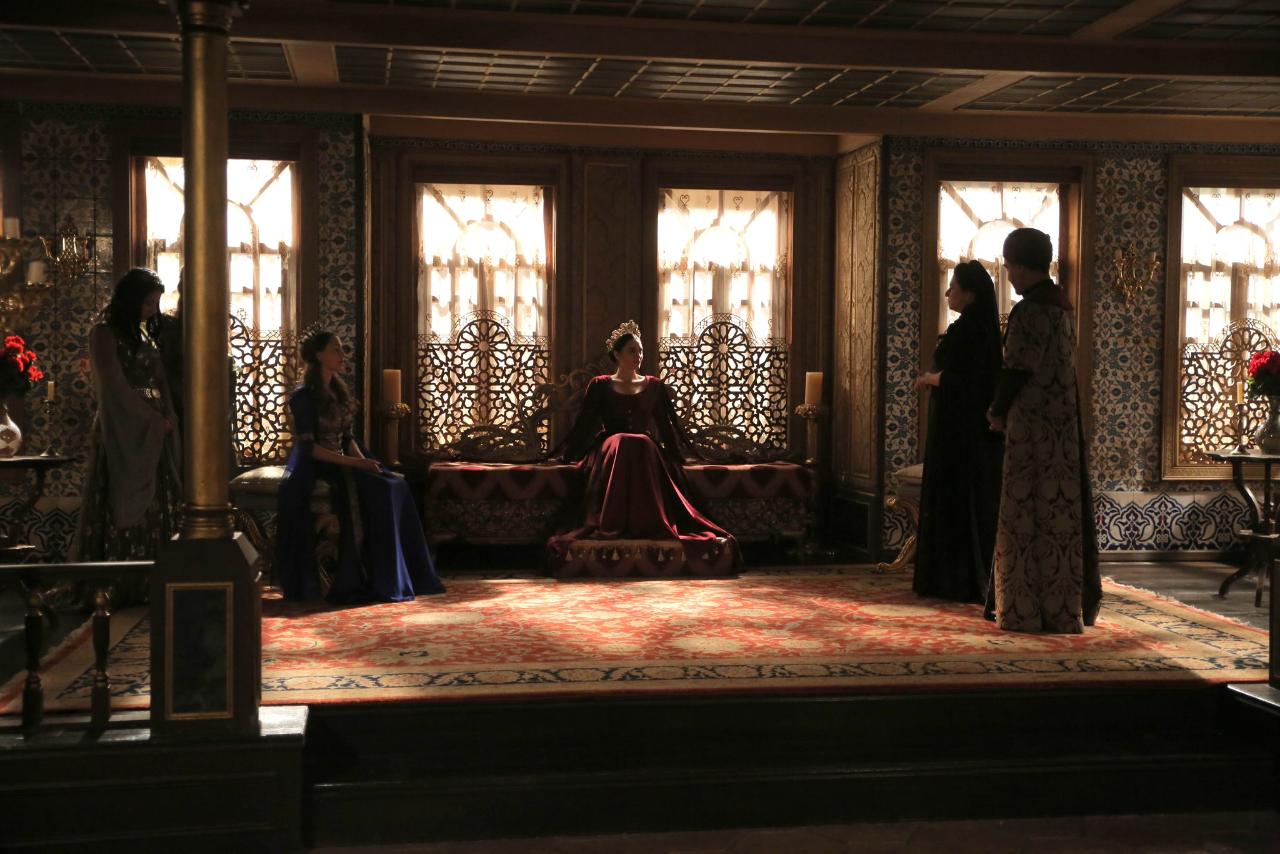
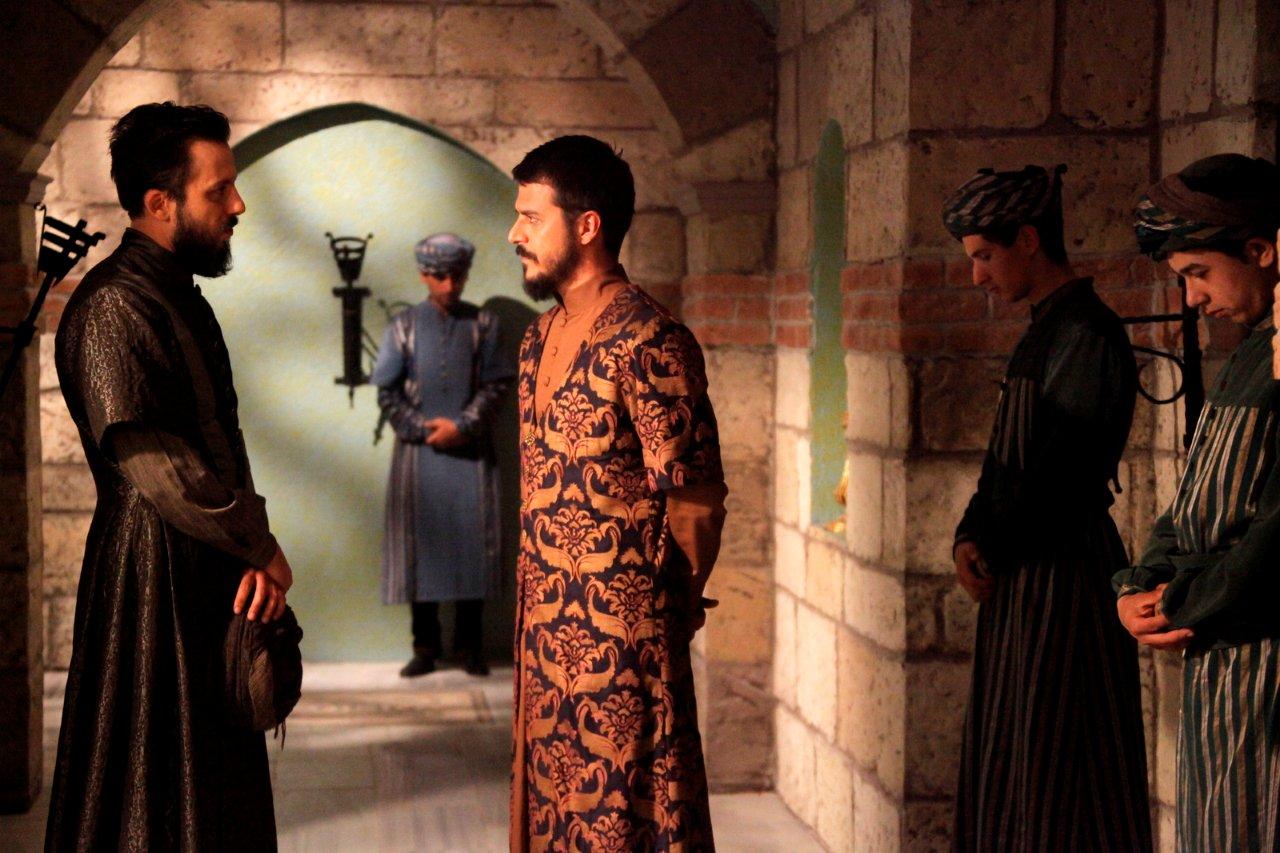
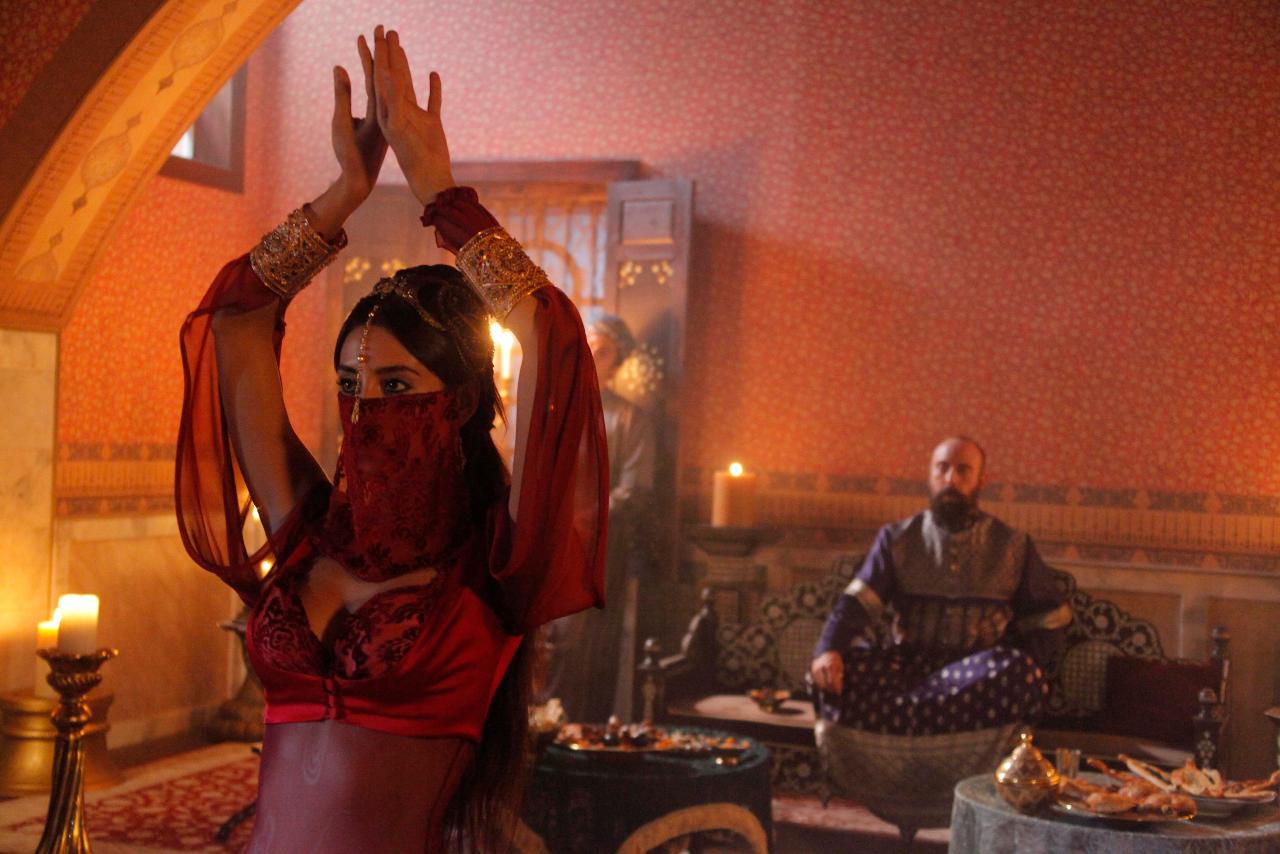

History of Topkapı Palace
Topkapı Palace is in a remarkable location with a rich history stretching back thousands of years. Here, on a promontory at the Golden Horn Bay, people have been settling here since the Neolithic period. Arrowheads, ceramics and other artifacts in the remains of the primitive settlement found here were made about 8600 years ago. On the Topkapı site, archaeologists have discovered an authentic stone chronicle, its time-honored pages make up the cultural layers of all subsequent eras.
.
According to ancient legends, about which we know from the books of ancient Greek and Roman historians, in 667 BC here founded a settlement of Greek colonists who came from the ancient Megara, which is near Athens. The settlers named the city in honor of King Byzantium, who led the campaign. When the provincial polis of Byzantium was chosen as the capital of the Eastern Roman Empire, the huge palace of the Byzantine Basileus was built on the promontory, and the city was renamed in honor of Emperor Constantine.
.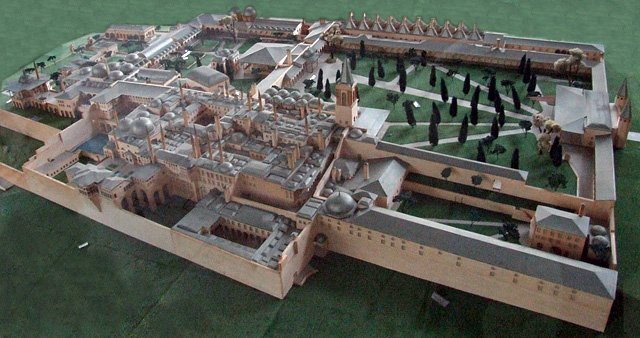
.
The main gate, behind whose loopholes cannons were hidden, gave the name to the new palace of powerful sultans: “Topkapi” literally means “Cannon Gate”. They are located near the Hagia Sophia Cathedral.
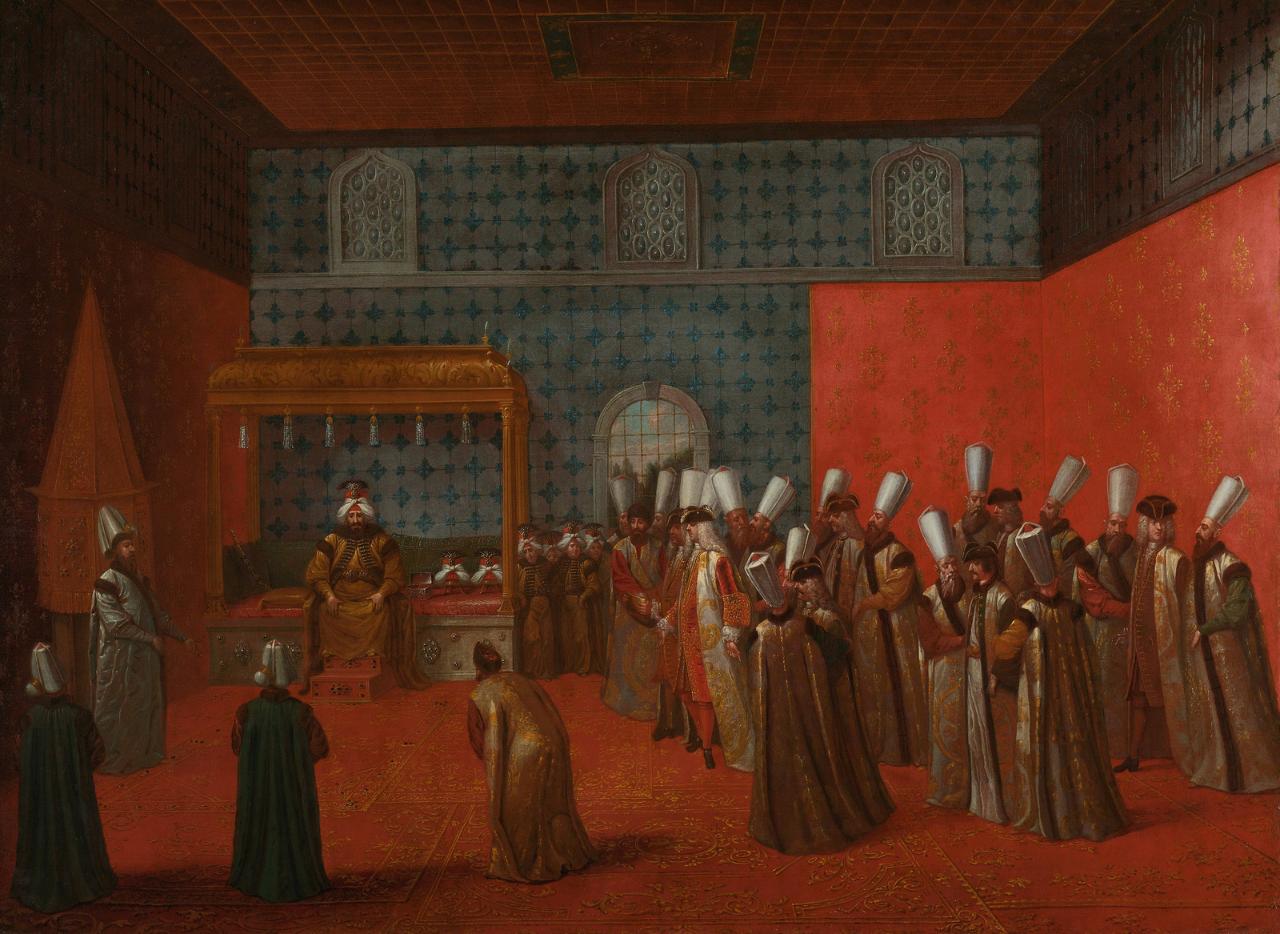
.
After World War I, the dilapidated six-hundred-year-old Ottoman Empire collapsed. In 1924, on the orders of Turkish revolutionary leader Mustafa Ataturk, Topkapi Palace was turned into a museum and opened to the public.
.
Museum facilities and exhibitions
The Topkapı area is divided by galleries, walls and gates into several courtyards with palaces and arbors, armory, guards barracks, stables, baths, food stores and other services. Secret passages leading to the sultan’s chambers and beyond are dug beneath them. Many of these dungeons served the Byzantines.
.Nowadays, the buildings of the palace complex house thematic museum exhibitions.
.Janissary Court
The first gates in the fortress wall were erected in 1478. Later they were faced with marble. The arches are decorated with gilded Arabic script with quotations from the Koran. Here you can also see tugras – calligraphic monograms of Sultans Mehmed II and Abdul Aziz, under whom the gates were repaired. Tugras were used as a personal signature of rulers, they were carved on state seals, minted on coins.
.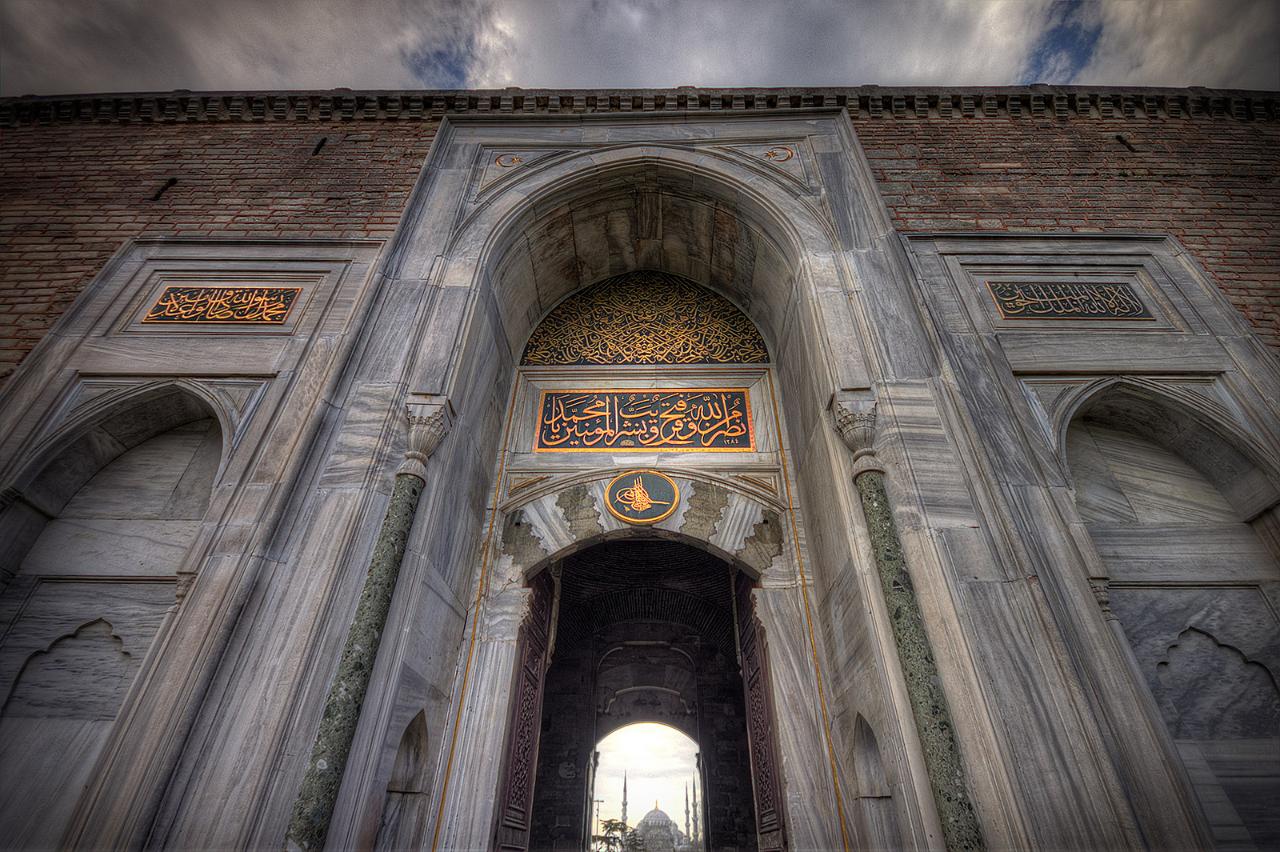
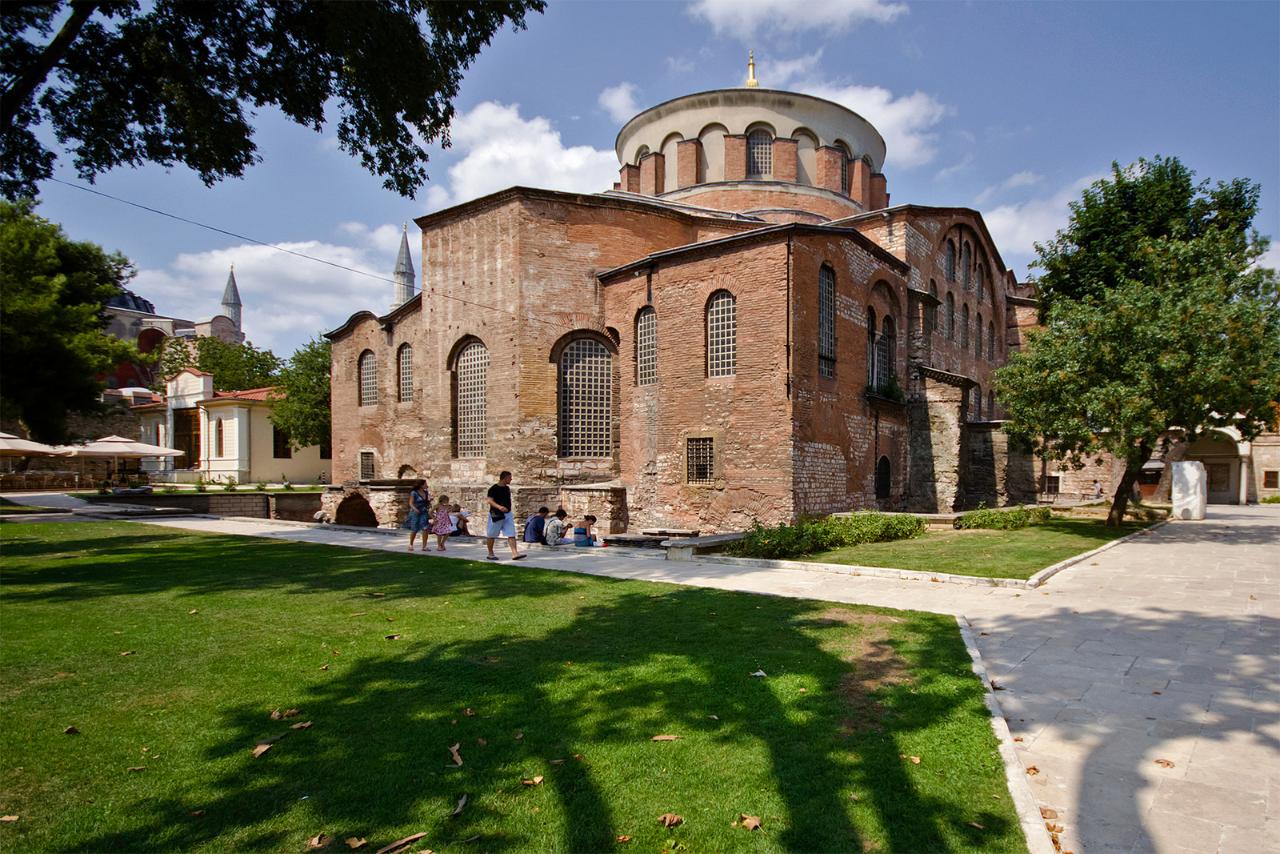
This gate, just south of the Topkapı palaces, leads to the Yanycharski Court, where the museum’s ticket office is located. Here, to the left of the entrance, is the first museum site included in the Topkapı complex, the Church of St. Irene (4th century), built on the ruins of an ancient temple of Aphrodite. It is one of the oldest surviving Christian basilicas in the world. Within its walls was held the First Council of Constantinople, convened by Emperor Theodosius in 381. In the VIII century, during the period of iconoclasm, all the paintings in the interiors were destroyed. Only the mosaic in the apse – a black cross on a golden background – was preserved.
After the conquest of Constantinople by the Turks, the church was not turned into a mosque, but served as an arsenal. In the early 2000s, restoration work was carried out here. Now the church, with its excellent acoustics, is used as a concert hall.
In the wall behind the church there is a passage to the former Ottoman Mint.
.Gates of Welcome
A tour of the Topkapi Museums begins at the main fortress gate. This entrance, made of beige sandstone blocks, is Topkapı’s recognizable trademark and is called Bab-us-Selam, which means Gates of Welcome. A rider of any rank had to dismount here; only the sultan, accompanied by his personal guard, could enter Topkapı on horseback.
.
In the gate octagonal towers with sharp spires of stone slab roofs criminals sentenced to death languished. Here, too, in the executioners’ room were the instruments of torture and the scaffold on which the unfortunate prisoners were stripped of their heads. Among them were noble aristocrats and unlucky relatives of the sultans who were found guilty of plotting against the lord of the universe. To terrorize the subjects, their remains were hung above the gates. They could not be interred according to Muslim customs. Guides claim that the ghosts of the executed still haunt the towers to this day. To the right of the gate is the marble fountain of the Executioner. Legend has it that in its bowl, craftsmen washed blood-stained swords in front of terrified passers-by.
.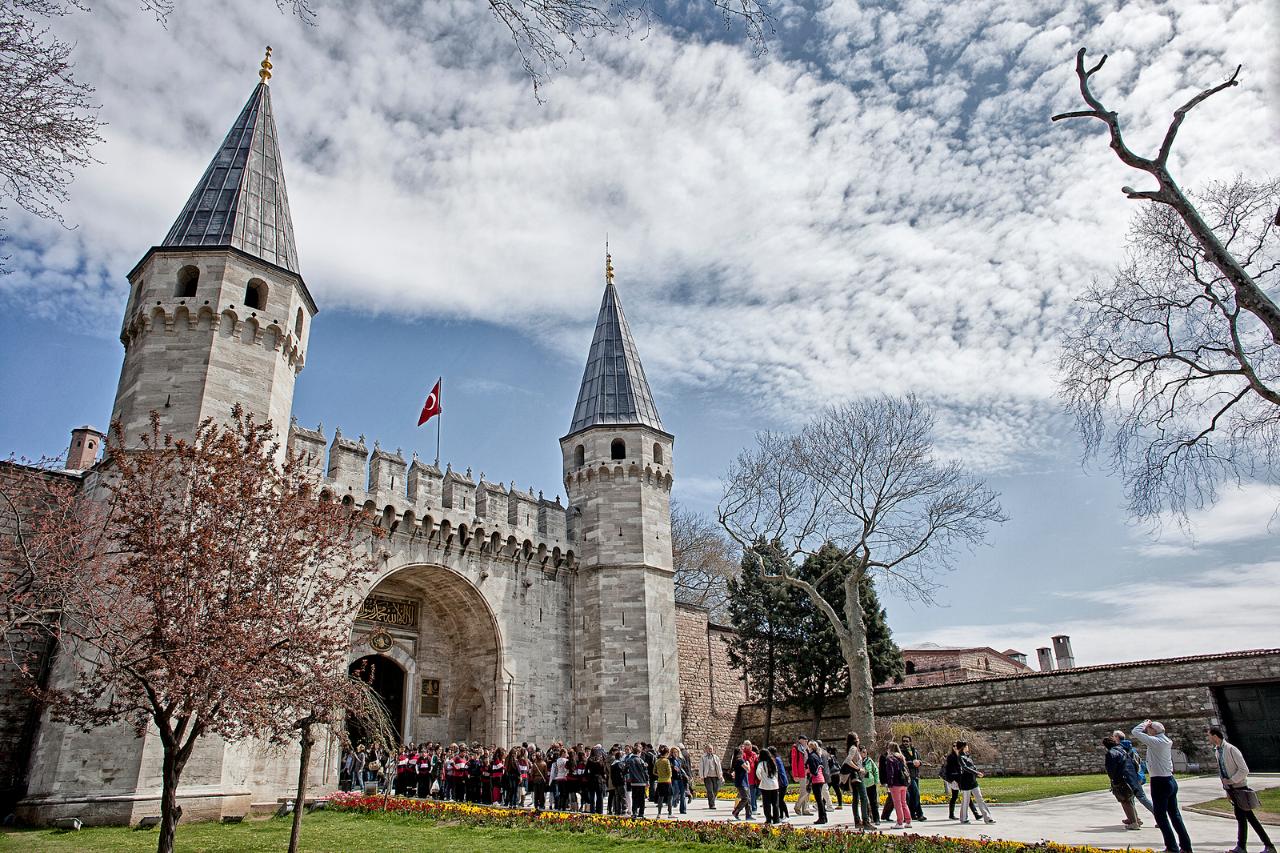
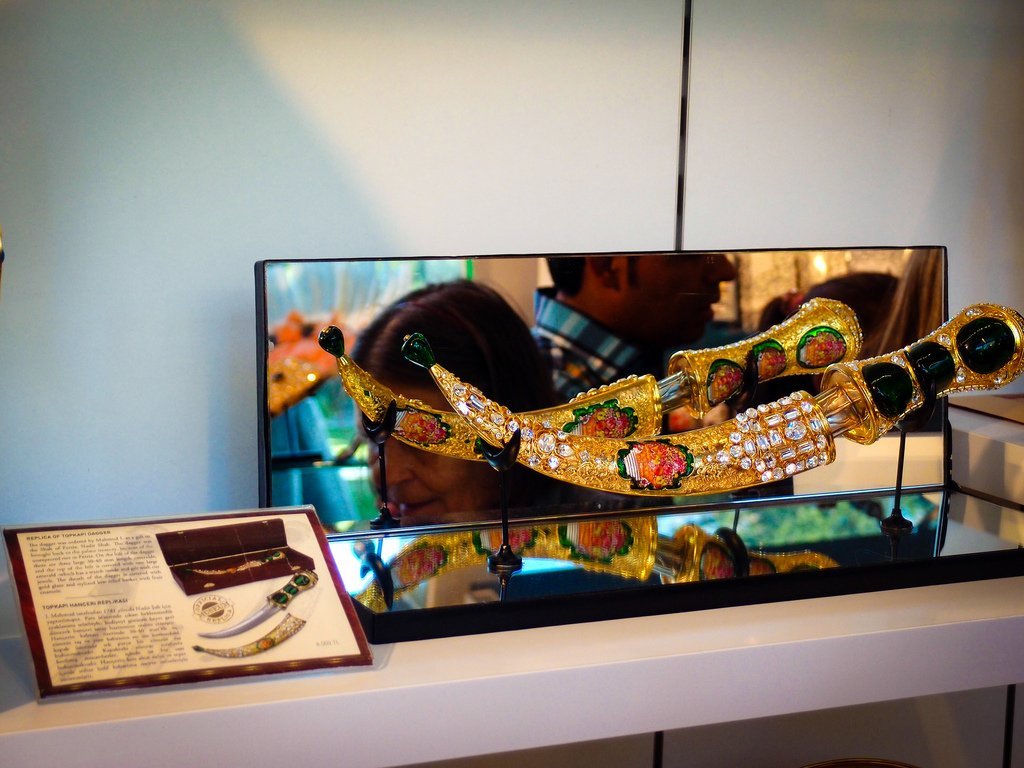
Beyond the gate is the most expansive courtyard of the residence, Meydana’s Divan. To the right of the entrance, by the fortress wall, is an exhibition of horse-drawn carriages. This courtyard housed the janissary barracks, stables, palace hospital, baths, bakeries and kitchen. The open-air square displays artifacts found by archaeologists in Topkapı – fragments of columns, sarcophagi, fragments of carved facades of the palace of Byzantine emperors. Recent excavations have also revealed that beneath the courtyard is a huge underground cistern erected by the Byzantines to collect and store water.
Divanhane
.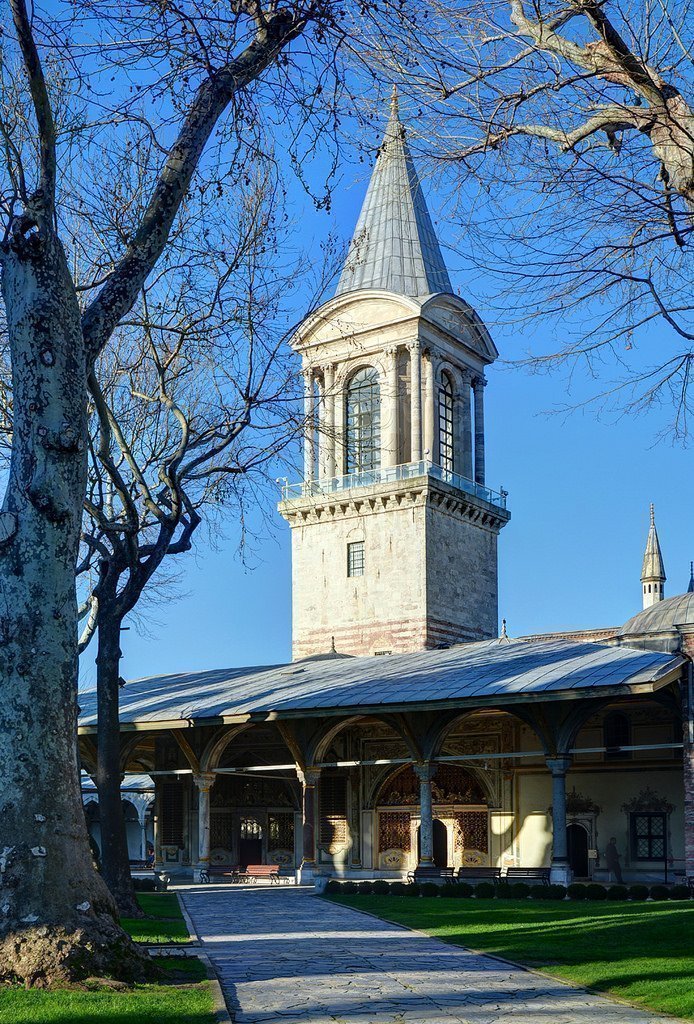
The room next to the meeting hall held handwritten sets of laws, acts of state, and archival documents of bygone years stacked in chests. In an adjoining room sat the secretaries and scribes who recorded on parchment scrolls all the decisions of the imperial council. Traditionally, grand celebrations were held under the Diwanhane dome when the sultan’s daughters were married.
.
The building was rebuilt in 1792, the portico was equipped with arched gates with patterned carvings in the then fashionable European Rococo style. Decorations on the facades were made in the same style. However, the interiors of the palace retained elements of Ottoman decor of the XVI century – marble lining of the walls, molding and carvings on the columns.
.Armory
Next to the Diwanhane is the Armory. Its arched halls contain rare weapons from the Sultan’s collections and Topkapı arsenals, from medieval bows and yatagans to the first muskets and a golden gun presented by the Queen of England. In total, more than 400 exhibits are on display.
.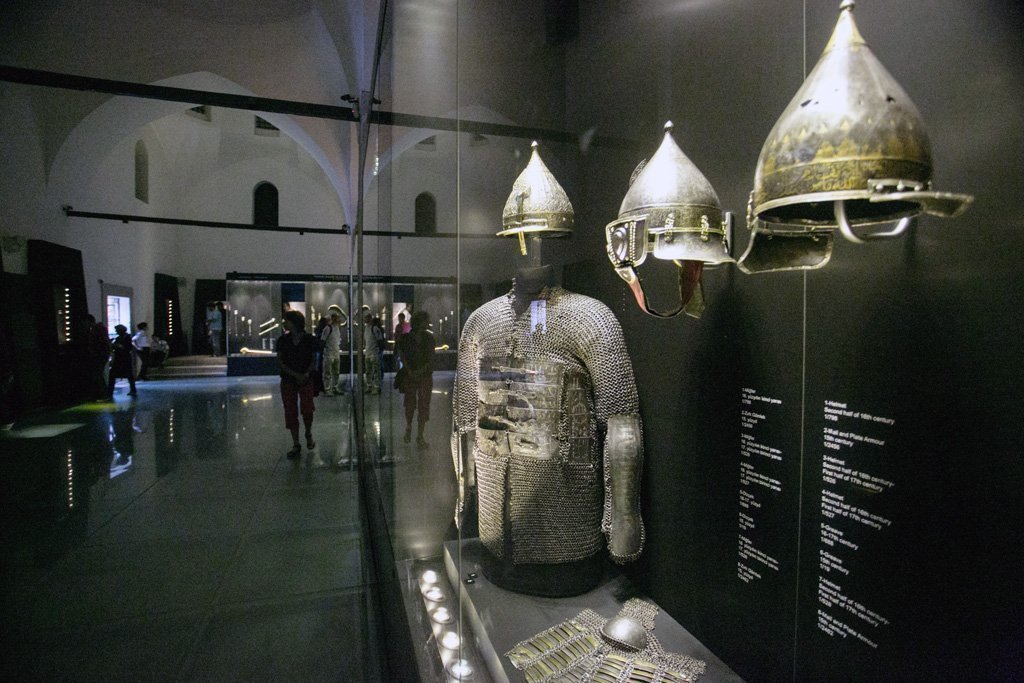
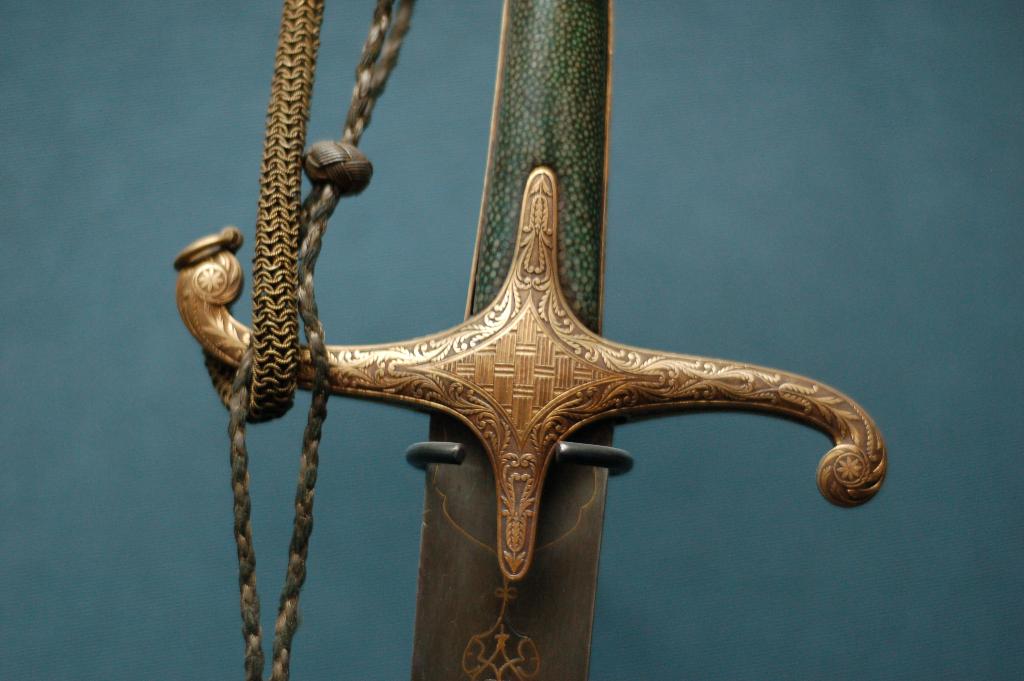
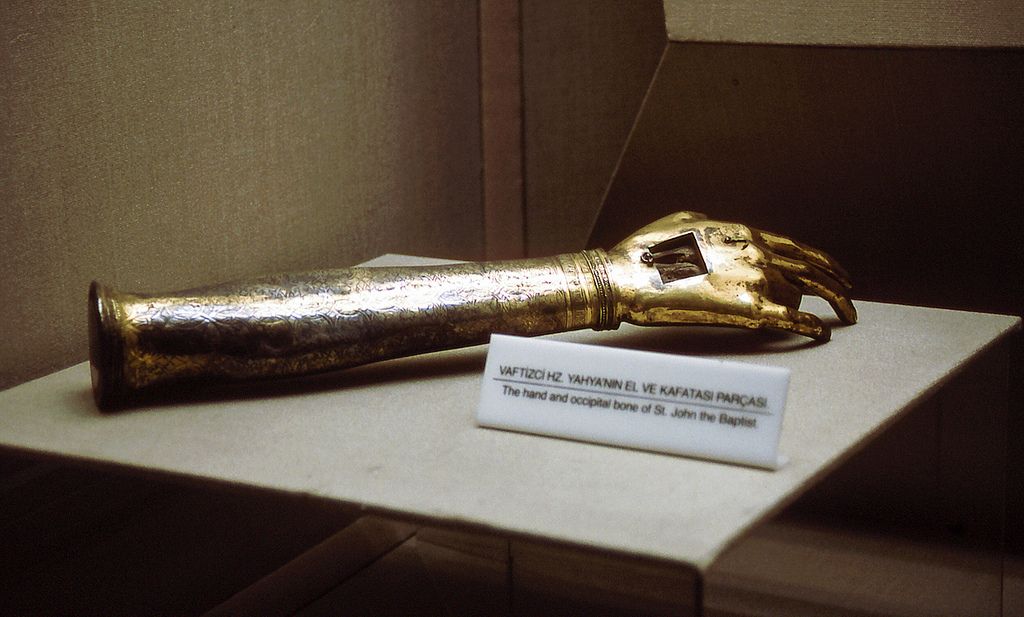
Here you can view the world’s richest collection of Islamic weapons, representing weapons dating back 1,200 years, starting with 7th century Arab swords. The exhibition includes many weapons, armor and insignia captured as war trophies in battles with the armies of European and Eastern states, from Iran and India to Austria and Russia. Notable are the two-handed swords of medieval European knights, with blades over two meters long. There are also gifts here, such as a samurai sword presented on behalf of the Japanese emperor.
.The showcases present the personal weapons of Turkish sultans – bows, richly decorated quivers and arrows of Bayezid II, gold-encrusted swords and sabers of other rulers.
.The museum has a magnificent view of the Bosphorus, one of the halls has access to an observation deck.
.Palace Kitchen
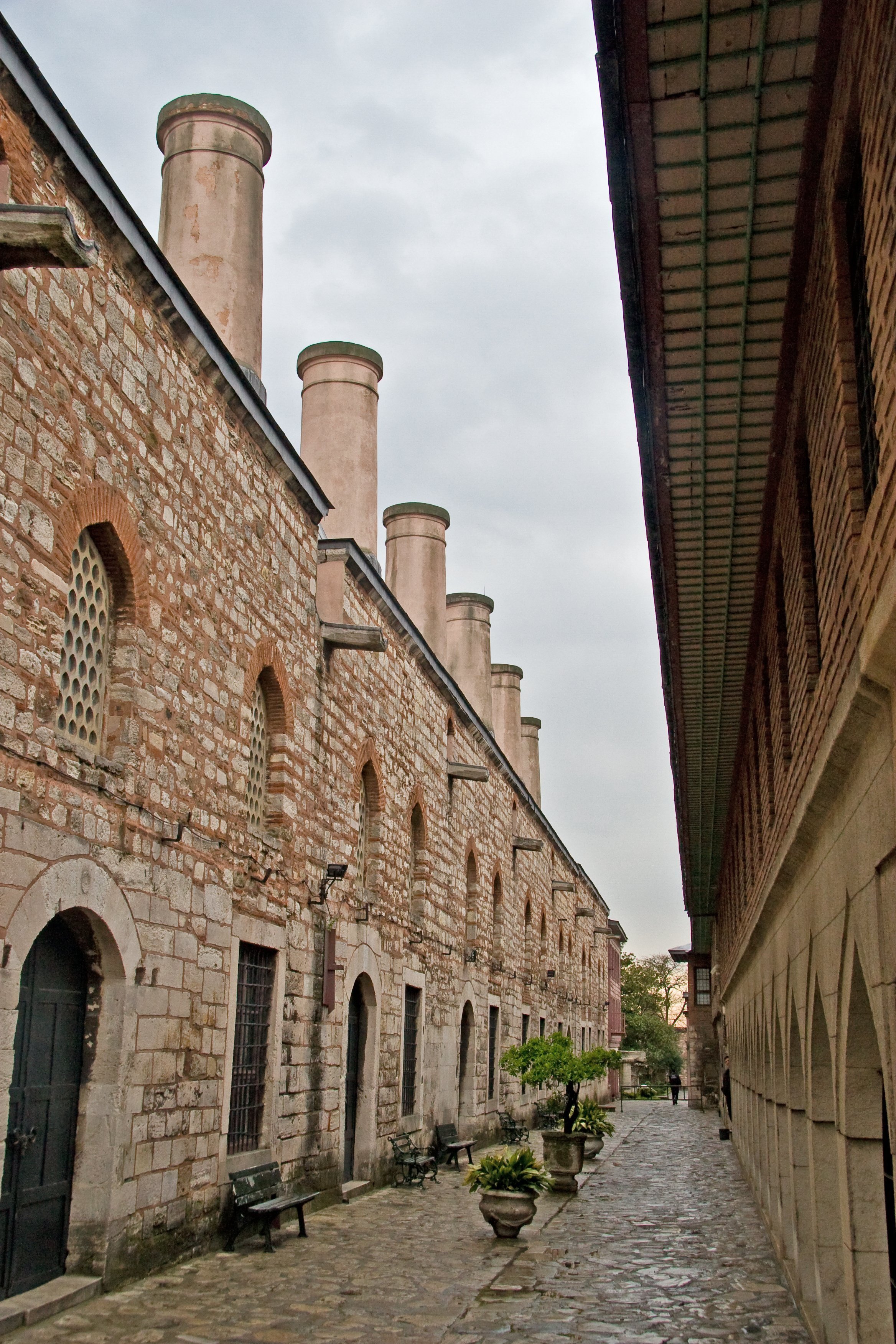
On stoves, in cauldrons and in ovens were prepared delicacies for the sultan’s table and harem dwellers, dinners for thousands of courtiers. In addition, the kitchen provided food for an army of soldiers guarding Topkapi. Generations of palace cooks invented many recipes for delicious dishes and desserts. They are described in detail in ancient cookbooks, and today tourists enjoy these delights in the best restaurants in Istanbul.
.The huge palace kitchen building houses museums featuring carpets, ceramics, porcelain, and ethnographic exhibitions. One room recreates the atmosphere of the kitchen itself. There is a curious collection of old kitchen utensils and copper cookware.
The silverware exhibition displays about 2,000 fine examples of the work of Turkish jewelers and chasers from the 16th to 19th centuries. These items were an important part of the Sultan’s treasury, because in the Ottoman Empire, wealth was measured primarily by the amount of silver. Many silver things are decorated with gift inscriptions, they were presented to the sultans for anniversaries and holidays.
.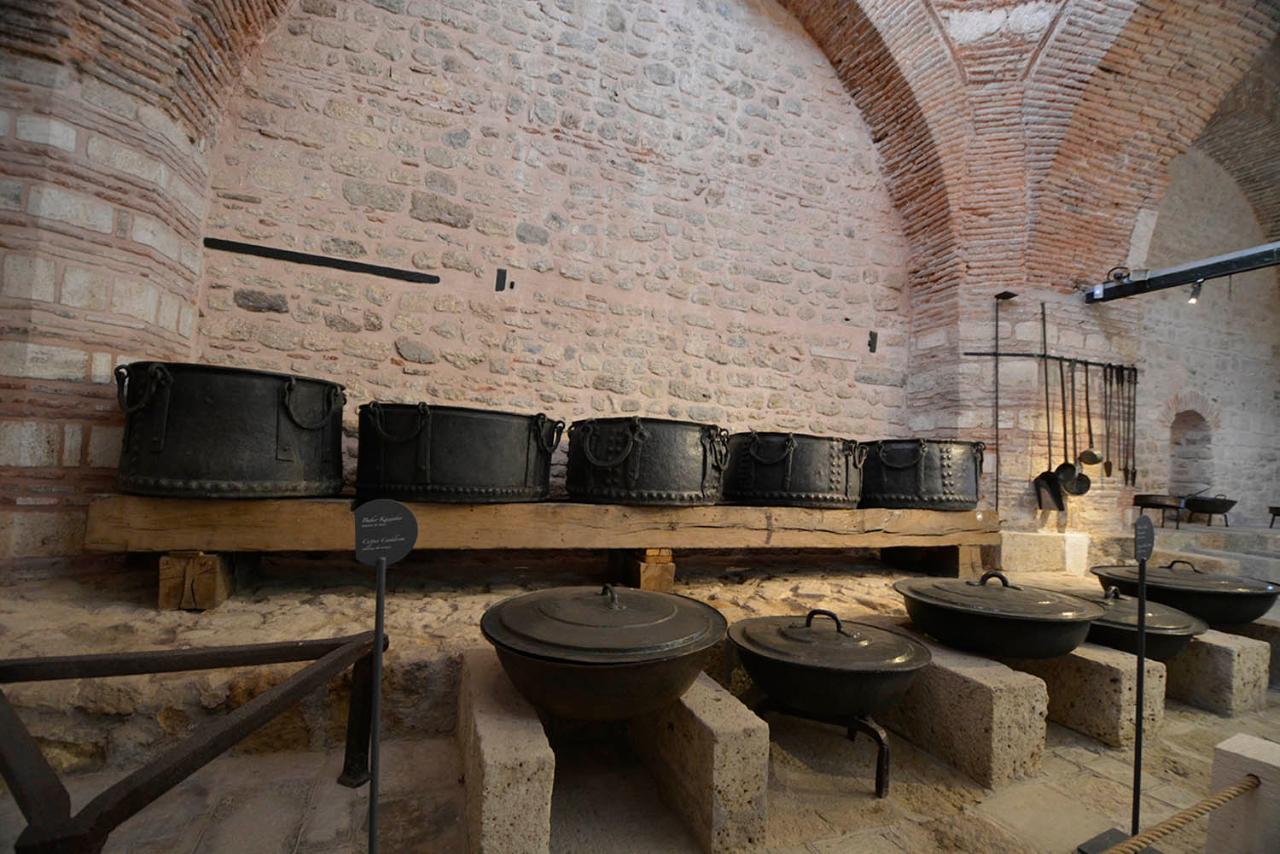
Chinese Porcelain
The Chinese Porcelain Museum is amazing in its abundance of exhibits. With around 10,700 pieces on display, it is the largest collection outside of China. The most valuable pieces are inlaid with gold and silver threads, emeralds and rubies. The oldest painted vases were made in the 13th century. The stamps indicate that several bowls of the finest porcelain under a yellow glaze belonged to serving pieces in the dining rooms of the palaces of medieval Chinese emperors.
.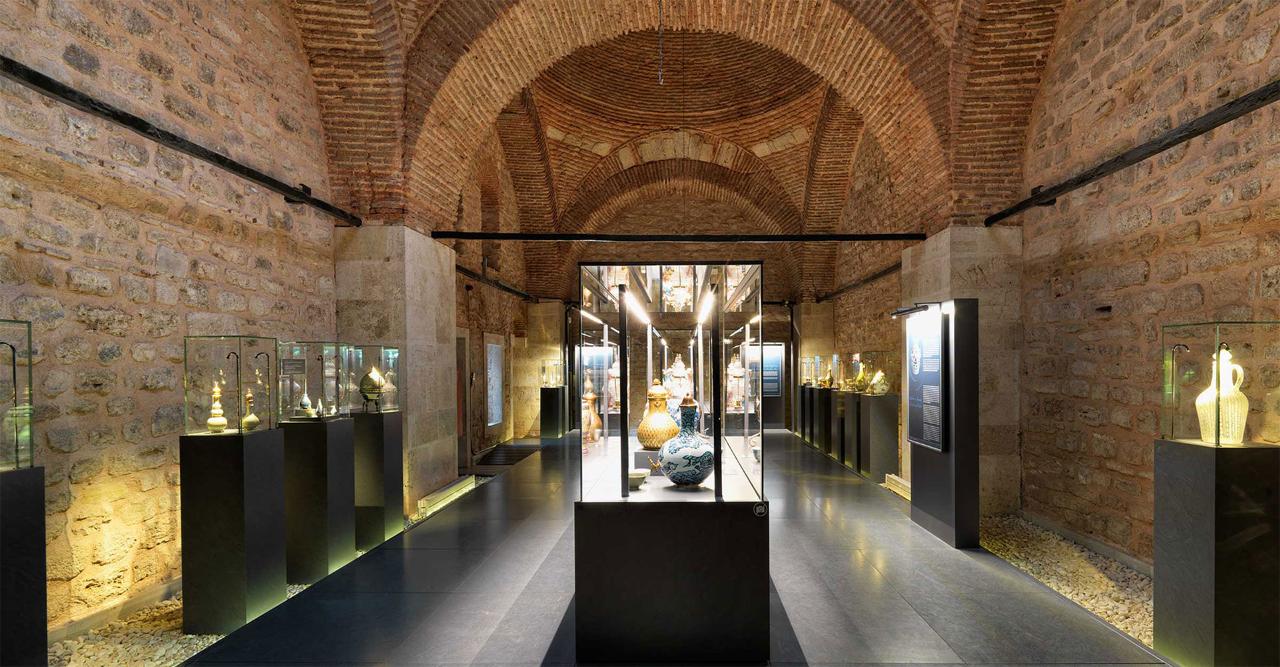

Note the group of items covered with a special celadon glaze of a grayish-green hue reminiscent of jade. According to ancient belief, poisoned drink, poured into such dishes, instantly loses poisonous properties and does not cause harm.
.
Separately presented 700 pieces of Japanese porcelain XVII-XVIII centuries.
.European porcelain
This porcelain collection features table sets, vases, porcelain clocks, candelabras and other decorative items produced in various European countries from the early 18th century to the early 20th century. There are 5000 exhibits here. The most valuable of them are diplomatic gifts to the sultans. Many of them are made taking into account the Ottoman artistic traditions.
.A great rarity are the first products of the Meissen porcelain manufactory, made in 1717: dishes, trays, caskets, candy boxes. Huge table service, painted with forest landscapes, in the 1830s sent by King Louis-Philippe of France.
.
The showcases display samples of Russian porcelain made in St. Petersburg. Among them is exhibited a part of a set of 2000 pieces sent by Emperor Nicholas I as a gift to Sultan Mahmud II.
.
The collection also includes items made of Bohemian, English and Russian crystal. Highlighted in this section are beautiful crystal glasses and a sherbet jug made by the famous master of the Bohemian Glassworks, Ludwig Moser, for Sultan Abdul-Hamid II.
.An exhibition of Turkish porcelain rounds out the collection.
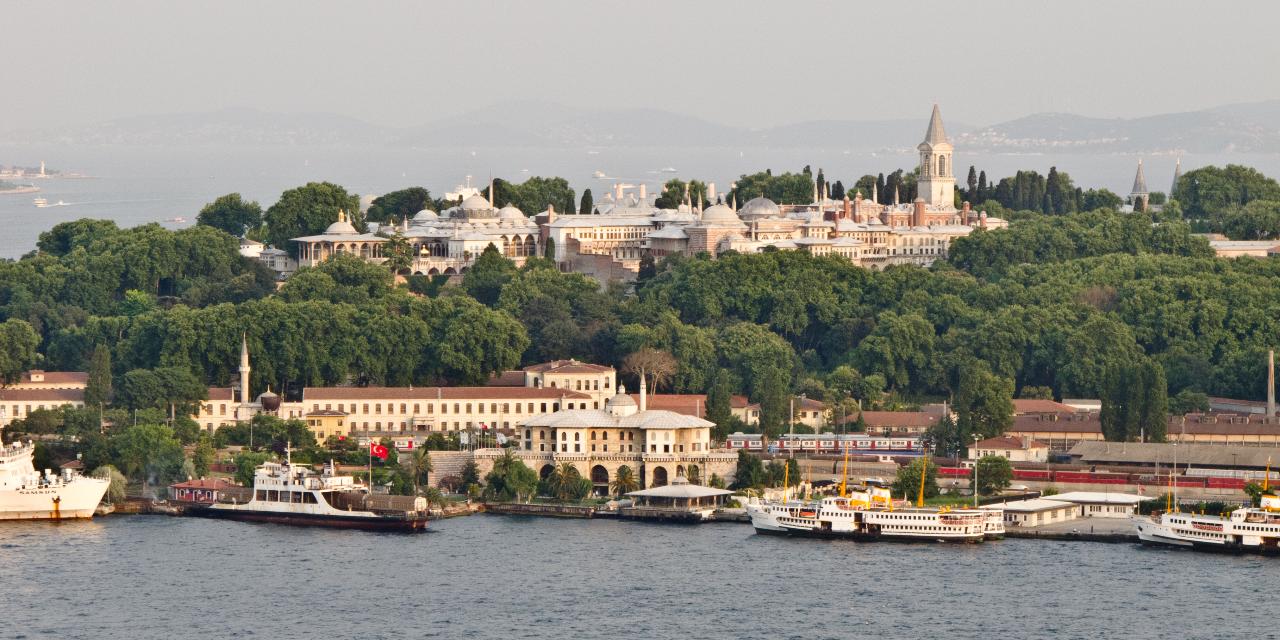
Enderun Palace
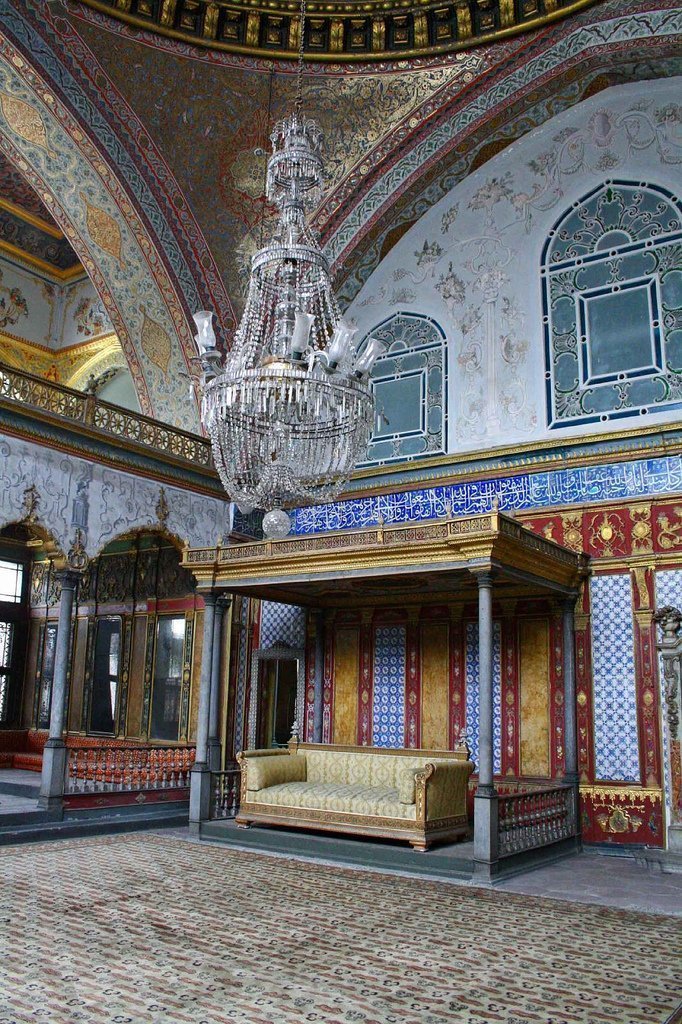
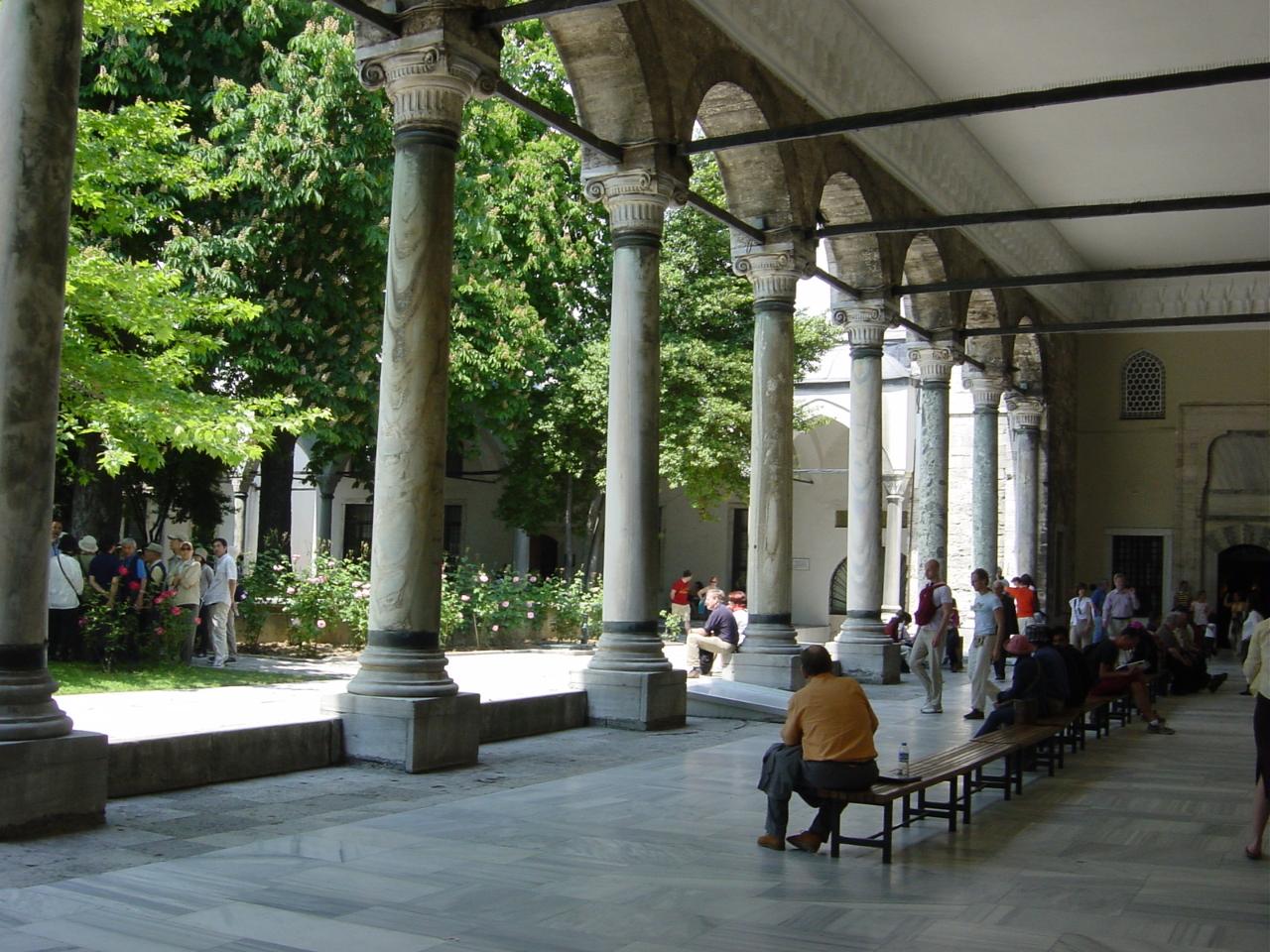
In the first hall, Mustafa III’s ceremonial armor, decorated with gold and precious gems, attracts attention. His sword, shield and stirrups are also lavishly decorated.
>Here you can also see the ebony throne of Murad IV, inlaid with ivory and mother-of-pearl.
.On one of the showcases shimmers a precious jade bowl. It was presented to the Turkish Sultan Abdul-Hamid II by Russian Emperor Nicholas II.
.
In the center of the second hall is a walnut throne of Ahmed I, inlaid with tortoise shell, mother-of-pearl and semi-precious stones. Under the brocade canopy on a gold chain hangs a huge emerald. There are also military trophies, among them the golden throne of the Iranian Shah Ismail, defeated by the army of Suleiman the Magnificent.
.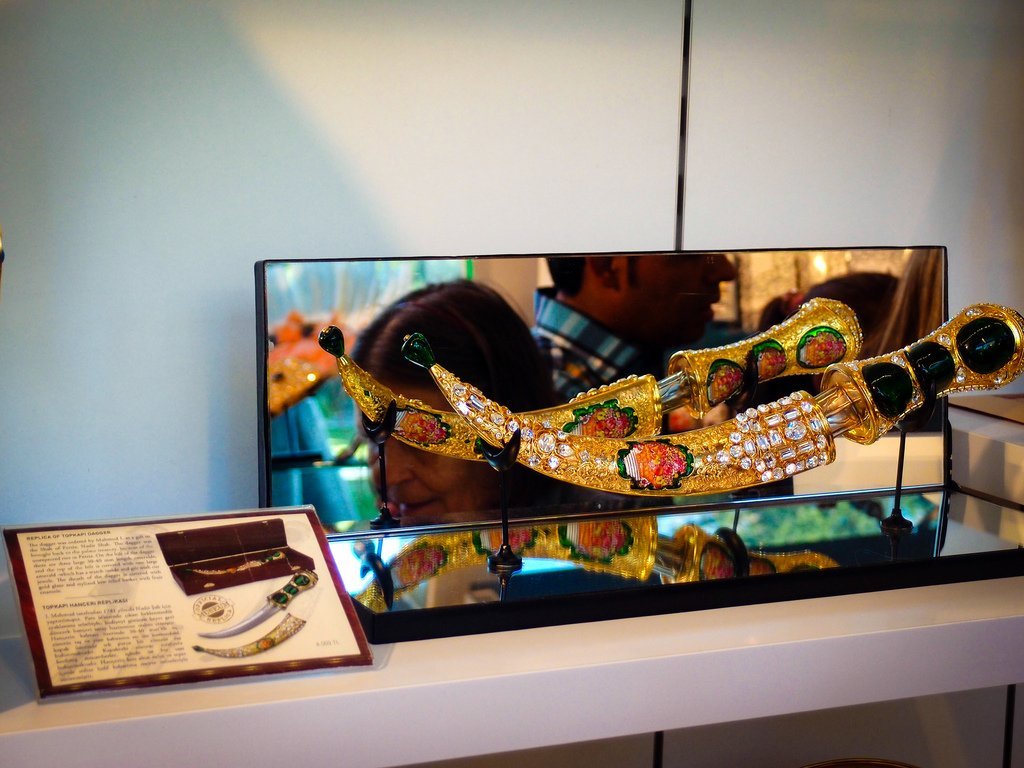
The third hall of the treasury exhibits the most valuable piece of the collection, a large pear-shaped Kaşıkçi diamond in a setting surrounded by a double row of 49 smaller diamonds. It is not known how this 86-carat jewel appeared in the palace. There are many versions of the origin of the famous diamond. According to one legend, it was found on the shore of the Bosphorus by a poor fisherman and taken to a jewelry shop in the Istanbul bazaar. The cunning jeweler convinced the fisherman that his find was a glass trinket and exchanged the treasure for three pewter spoons. Whether the story is true or not, the name of the gemstone “Kashikchi” means “Spooner”. There are also fanciful stories that this diamond belonged to either Count Cagliostro or Napoleon Bonaparte’s mother.
.Harem
The fourth courtyard, which once held the status of a forbidden place, housed the sultan’s quarters, the harem, the quarters of the mothers of the ruling rulers, who bore the title of Valide Sultan. This part of Topkapi was only accessible to the sultan, his family members and a few top dignitaries.
.The palaces are surrounded by beautiful gardens with pavilions and pavilions, galleries overlooking the Bosphorus. There is also a palace library, a clock exhibition and a gallery of portraits of the rulers of the Ottoman Empire.
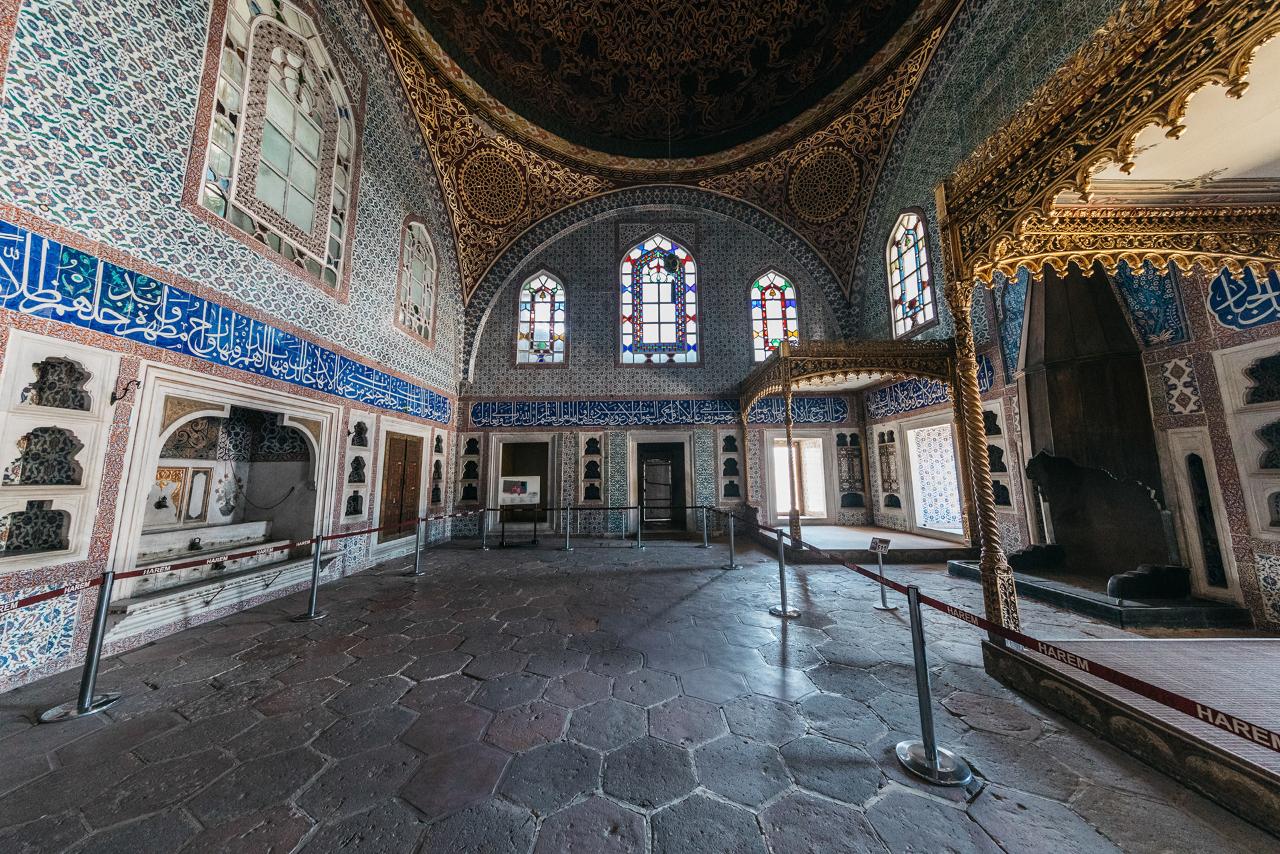
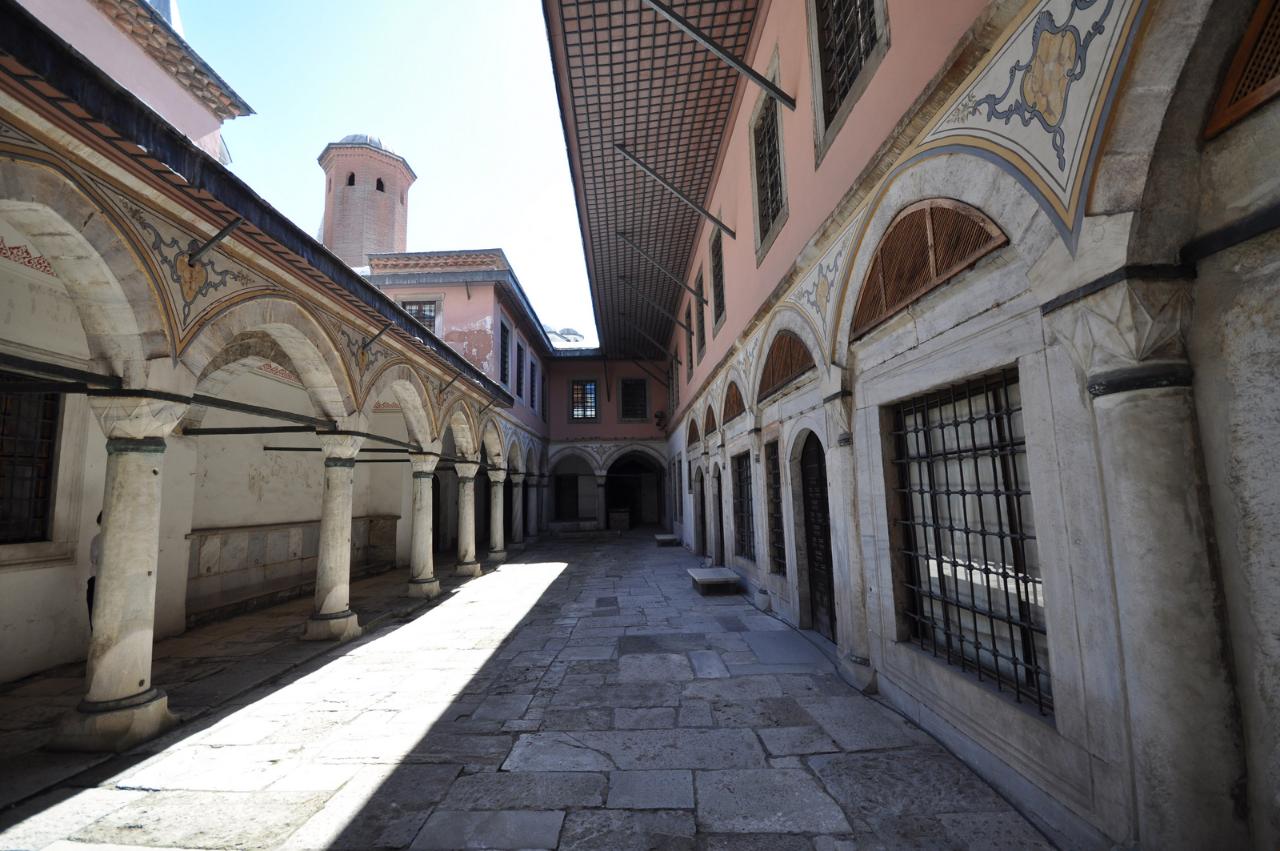
The Vault of Sacred Relics contains several artifacts and personal belongings of the Prophet Muhammad that are especially revered in the Muslim world. The oldest manuscript of the Quran, created in the 8th century, which corresponds to the end of the first century of Muslim chronology, is kept here.
>
Practical information
Topkapı Museum is open daily from 09:00 to 18:00 (until 16:00 in winter). The day off is Tuesday. During religious holidays, the museum opens in the afternoon. The entrance ticket costs 60 liras. The ticket office closes at 17:00.
.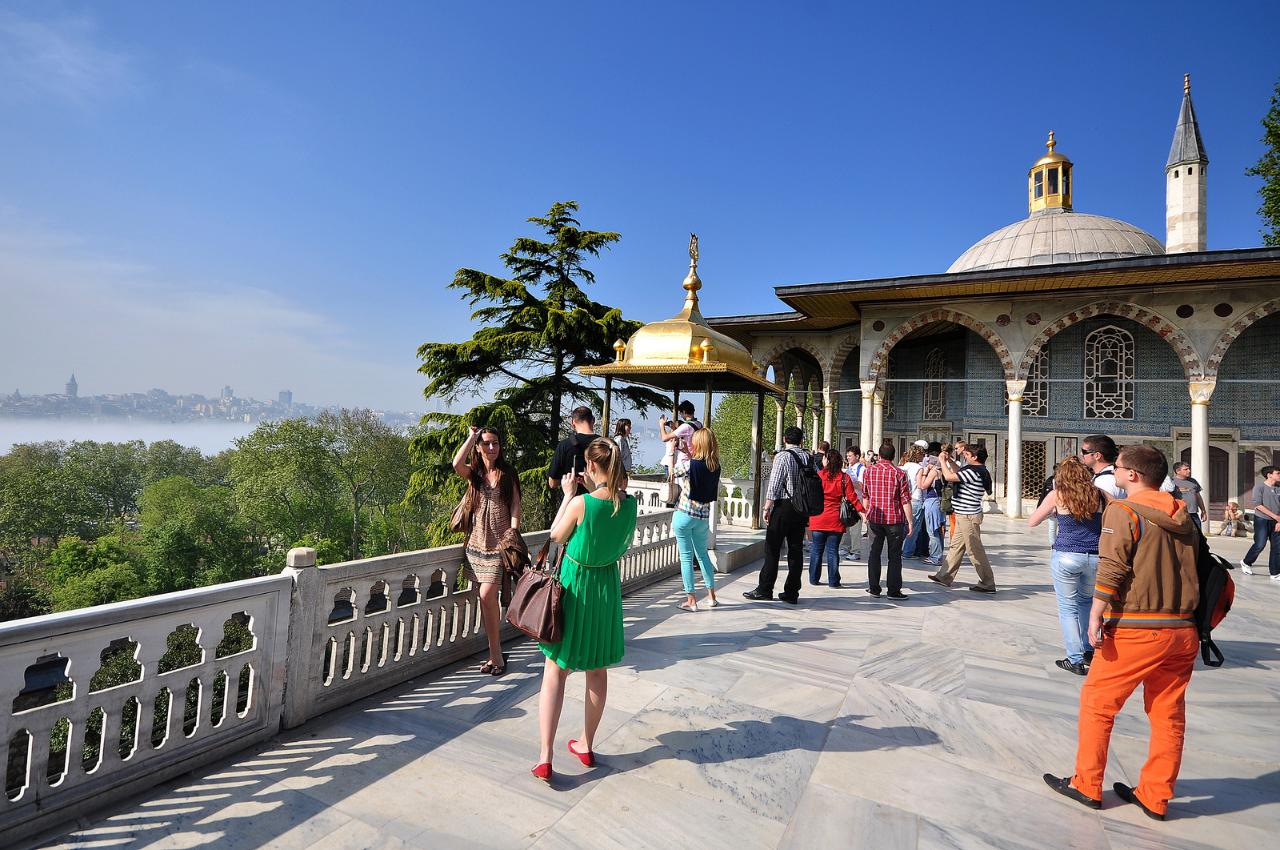
.
Getting here is convenient by high-speed streetcar – line T1, stop Sultanahmet or Gulhane.
.